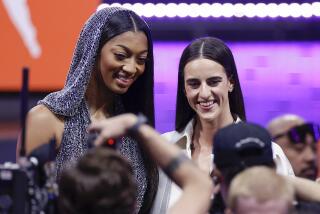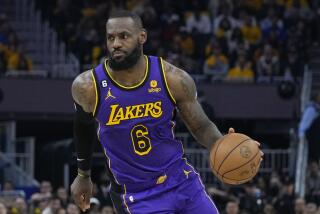The NBA / Gordon Edes : When It’s Christmas, It’s Time to Get Into the Spirit of Fighting
- Share via
Tis the season to . . . be fighting in the NBA?
“It seems we have a couple of incidents around the Christmas season every year,” said Rod Thorn, the NBA’s vice president of operations.
“Why that is, I don’t know. I guess we’ll have to let the sociologists answer that one.”
Last week’s fight card, which included four bouts in three nights, read like this:
--Patrick Ewing, Knicks, vs. Greg Kite, Celtics.
--Vinnie Johnson, Pistons, vs. Tree Rollins, Hawks.
--John Long, Pacers, vs. Rick Carlisle, Celtics.
--Akeem Olajuwon, Rockets, vs. Clemon Johnson, SuperSonics.
Thorn, who polices such affairs, already has handed out $13,000 in fines to the principals of the first three fights, as well as to teammates who left the bench area during the skirmishes. Monday afternoon, he planned to watch videotapes of the Olajuwon-Clemon Johnson heavyweight tilt; more fines are expected.
What’s going on here? Will Rodney Dangerfield have to change his joke to say: “I went to a hockey game last night and a basketball game broke out?”
Thorn doesn’t think so. “We’re hoping it’s an aberration,” he said from his New York office Monday. “Until last week, we’d had fewer incidents than we’d had in the last five or six years.
“And by the severity of the fines, we’re letting people know the league is not condoning fisticuffs. . . . Fighting doesn’t sell tickets.”
Maybe it does in hockey, but basketball is still haunted by the specter of the Kermit Washington-Rudy Tomjanovich fight in 1977, in which Washington, then with the Lakers, struck the Rocket forward in the face with such force that it took a series of operations to rebuild Tomjanovich’s face.
“We cannot tolerate fighting,” said Brian McIntyre, the NBA’s director of public relations, “because too much damage can be done.”
There will always be fights, of course, in a game of such physical contact played in such a confined area.
Willis Reed once took on the whole Laker team in the mid-60s. Bill Russell knocked out Jim Krebs with one punch. Kareem Abdul-Jabbar punched out Kent Benson (and was fined $5,000). Calvin Murphy, a bantamweight, knocked out Sidney Wicks.
But they’re becoming fewer, according to Jerry West, the Lakers’ general manager.
“Chick (Hearn, the Laker broadcaster) keeps talking about the size of the court (contributing to fights), but that’s baloney,” West said. “Fights will happen with people who are highly competitive.”
West said he came close to blows once. “It was late in a ballgame, and I was trying to run the clock out, dribbling the ball. A guy fouled me, I turned around and threw the ball in his face, and he took a swing at me.”
When a fight occurs, the NBA’s security department attempts to interview the principals involved, including the referees. Thorn then reviews tapes of the incident, before rendering a verdict.
“We try to ascertain what happened from the time the combatants entered the game, to see if something happened in the game to precipitate the incident,” Thorn said.
Fines are weighted heavier toward the instigator of the fight, Thorn said, “although there is no provocation for punching someone in the face.”
In the Vinnie Johnson-Tree Rollins fight, for example, Rollins scored the most blows, but in Thorn’s judgment, “Vinnie Johnson sought Tree out, he pushed him and swung at him. Then Tree wore him out after that.”
Johnson was fined $2,500. Rollins--who, in another celebrated fight, was accused of biting Boston’s Danny Ainge--was fined $2,000.
Thorn was present at the Knick-Celtic game last week in which Ewing went after Kite, first throwing an elbow, then a couple of punches.
“I didn’t see the fight,” he said. “I was watching the ball, like most fans.”
If the referees had seen the elbow, Thorn said, Ewing probably would have been thrown out of the game.
Kite did not retaliate, and thus was not fined. But the next night, when he came off the bench during the Long-Carlisle fight, he was fined $500.
Norm Nixon, the injured Clipper guard, took some shots at his former team, the Lakers, especially GM Jerry West and guard Byron Scott in a recent issue of a national magazine.
“Everything Jerry West has done has backfired,” Nixon was quoted as saying in the January issue of Inside Sports.
“Byron Scott hasn’t done crap and I’m still playin’ well.”
That last comment, of course, was made before Nixon tore up his knee in a softball game in Central Park last summer.
He had more to say about Scott, the player who succeeded him as Magic Johnson’s partner in the Laker backcourt.
“Byron Scott is a true second guard, a shootin’ guard. I’m a shootin’ and ball-handling guard. Magic and I created so many problems for a team, but we could also disappear in games, rest, run around, and do nothing for seven or eight minutes and not worry about creating.
“Those guys (the Lakers) won two years ago with Byron back there, but it’s an accumulation thing. Magic was worn down and overworked last year, and it showed when they lost to Houston.
“I definitely would’ve helped if I’d been there. You would’ve had Robert Reid trying to guard me. Or Lewis Lloyd, same thing. I would’ve exploited them to death.”
Nixon’s problems with West stem from the days West was still coaching the team and, according to Nixon, picked on the guard, then a rookie, incessantly.
The heavy-handed treatment continued, Nixon charged, after West moved into the front office, the source, Nixon believes, of the drug rumors that surrounded him when he was traded to the Clippers.
On that subject, he said: “You can’t play as many games and minutes as I do and be a drug addict.”
He also said, however, that “everyone experiments with drugs,” adding that when he was in college, he “bought a lot of Quaaludes, marijuana, a little bit of coke . . . “ In the NBA, he said, “you’re more conscious . . . of takin’ care of yourself.”
More to Read
Go beyond the scoreboard
Get the latest on L.A.'s teams in the daily Sports Report newsletter.
You may occasionally receive promotional content from the Los Angeles Times.










